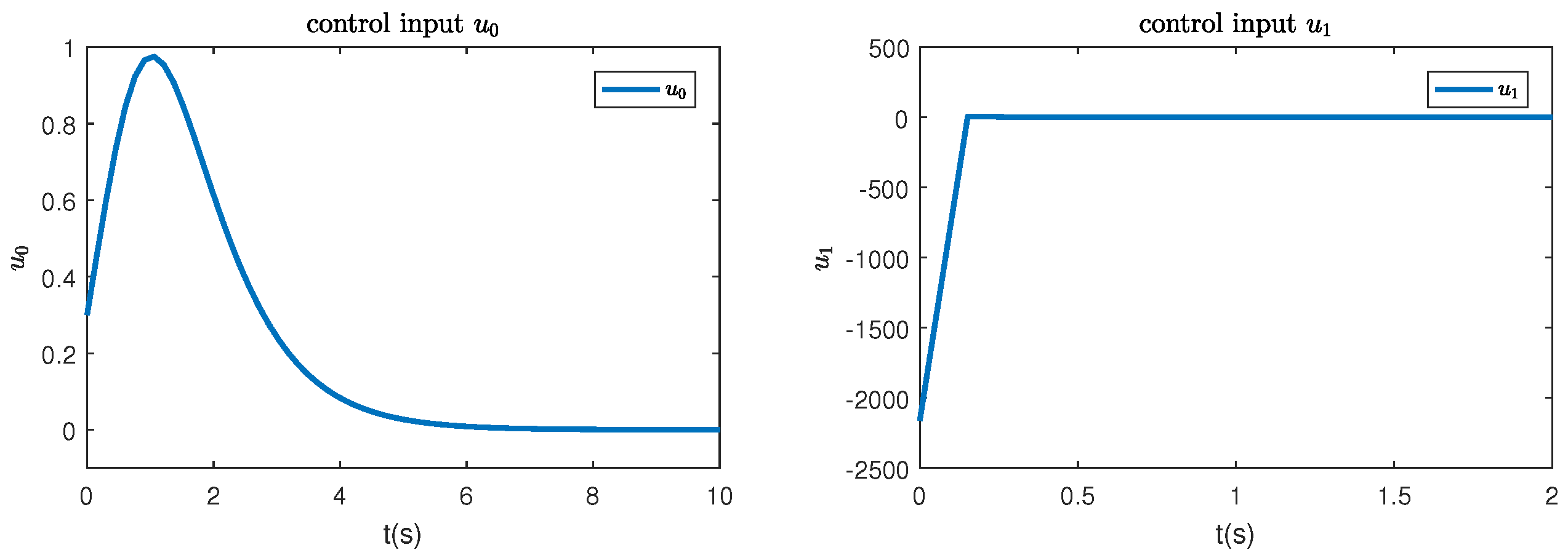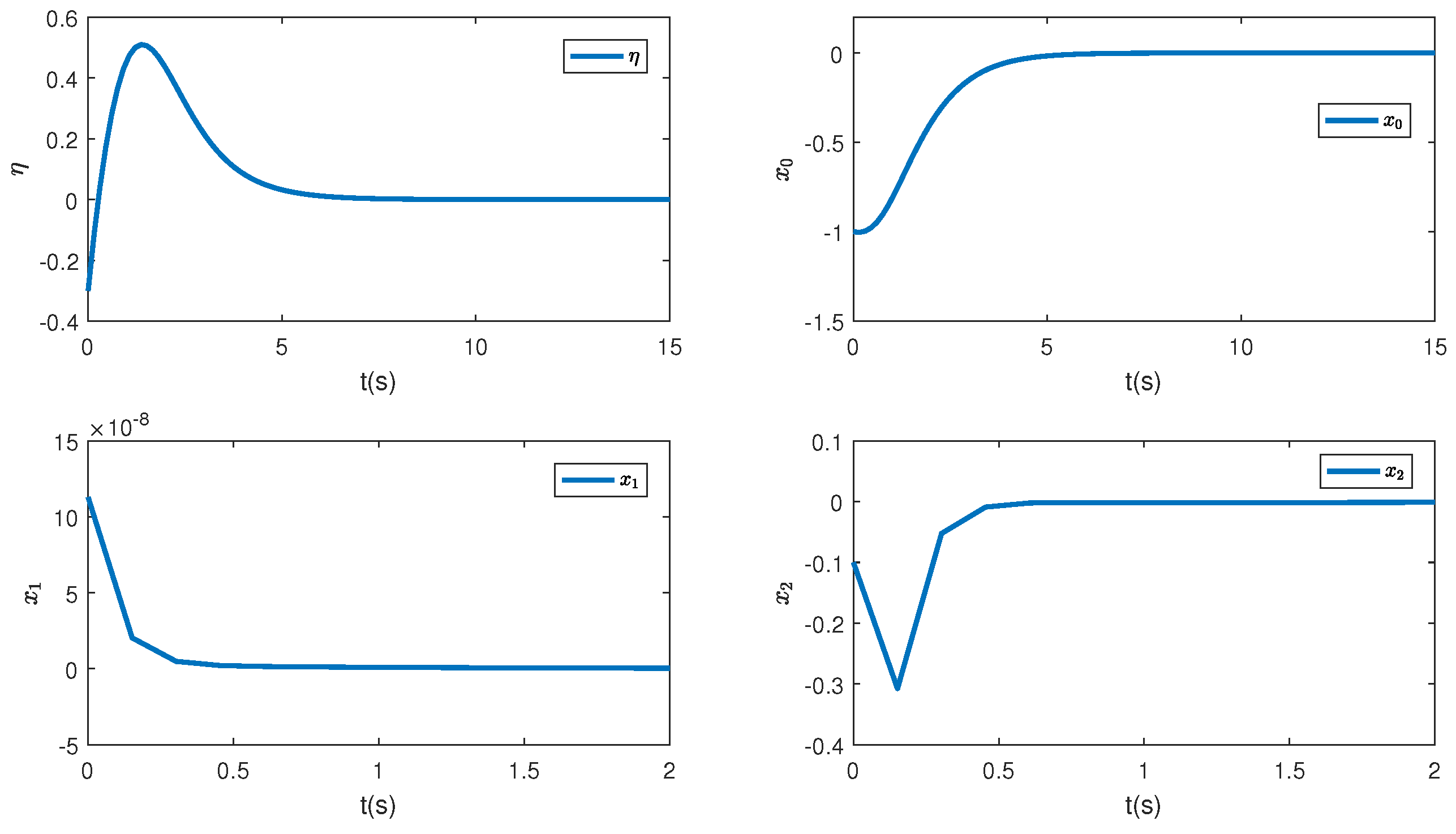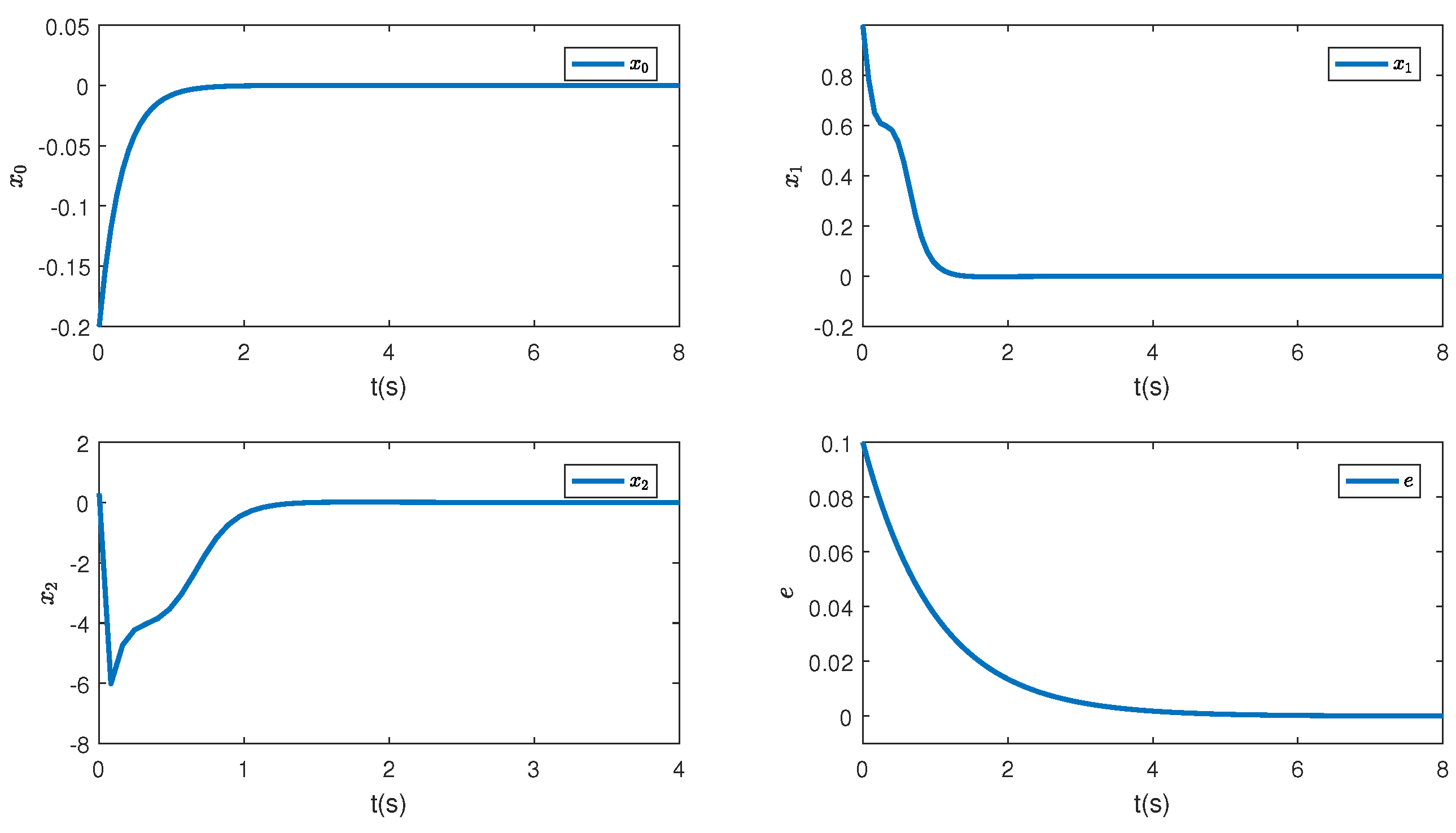Adaptive Output Feedback Control for Nonholonomic Chained Systems with Integral Input State Stability Inverse Dynamics
Abstract
1. Introduction
2. Preliminary Results
3. Output Feedback Controller
3.1. Controller Design for
3.2. Controller Design for
4. Switching Controller
5. Simulation Example
6. Conclusions
Author Contributions
Funding
Institutional Review Board Statement
Informed Consent Statement
Data Availability Statement
Conflicts of Interest
References
- Ye, D.; Zou, A.M.; Sun, Z. Predefined-time predefined-bounded attitude tracking control for rigid spacecraft. IEEE Trans. Aerosp. Electron. Syst. 2021, 58, 464–472. [Google Scholar] [CrossRef]
- Xin, J.; Meng, C.; Schulte, F.; Peng, J.; Liu, Y.; Negenborn, R.R. A time-space network model for collision-free routing of planar motions in a multirobot station. IEEE Trans. Ind. Inform. 2020, 16, 6413–6422. [Google Scholar] [CrossRef]
- Sandakalum, T.; Ang, M.H., Jr. Motion planning for mobile manipulators—A systematic review. Machines 2022, 10, 97. [Google Scholar] [CrossRef]
- Rabbani, M.J.; Memon, A.Y. Trajectory tracking and stabilization of nonholonomic wheeled mobile robot using recursive integral backstepping control. Electronics 2021, 10, 1992. [Google Scholar] [CrossRef]
- Zhang, X.; He, W.; Zhang, Y. An Adaptive Output Feedback Controller for Boost Converter. Electronics 2022, 11, 905. [Google Scholar] [CrossRef]
- Yeh, Y.L. Output Feedback Tracking Sliding Mode Control for Systems with State-and Input-Dependent Disturbances. Actuators 2021, 10, 117. [Google Scholar] [CrossRef]
- Li, Y.; Cai, B.; Song, X.; Chu, X.; Su, B. Modeling of maglev yaw system of wind turbines and its robust trajectory tracking control in the levitating and landing process based on NDOB. Asian J. Control 2019, 21, 770–782. [Google Scholar] [CrossRef]
- Brockett, R.W. Asymptotic stability and feedback stabilization. Differ. Geom. Control Theory 1983, 27, 181–208. [Google Scholar]
- Zhang, P.; Liu, T.; Jiang, Z.P. Systematic design of robust event-triggered state and output feedback controllers for uncertain nonholonomic systems. IEEE Trans. Autom. Control 2020, 66, 213–228. [Google Scholar] [CrossRef]
- Lai, X.; Zhang, P.; Wang, Y.; Chen, L.; Wu, M. Continuous state feedback control based on intelligent optimization for first-order nonholonomic systems. IEEE Trans. Syst. Man Cybern. Syst. 2018, 50, 2534–2540. [Google Scholar] [CrossRef]
- Rocha, E.; Castaños, F.; Moreno, J.A. Robust finite-time stabilisation of an arbitrary-order nonholonomic system in chained form. Automatica 2022, 135, 109956. [Google Scholar] [CrossRef]
- Gao, F.; Yuan, F.; Wu, Y. Adaptive stabilization for a class of stochastic nonlinearly parameterized nonholonomic systems with unknown control coefficients. Asian J. Control 2014, 16, 1829–1838. [Google Scholar] [CrossRef]
- Xu, L.; Wang, C.; Cai, X.; Xu, Y.; Jing, C. Two-layer distributed formation-containment control of multiple Euler–Lagrange systems with unknown control directions. Neurocomputing 2020, 387, 359–368. [Google Scholar] [CrossRef]
- Sontag, E.D. Smooth stabilization implies comprime factorization. IEEE Trans. Autom. Control 1989, 34, 435–443. [Google Scholar] [CrossRef]
- Ito, H.; Jiang, Z.P. Necessary and sufficient small gain conditions for integral input-to-state stable systems: A Lyapunov perspective. IEEE Trans. Autom. Control 2009, 54, 2389–2404. [Google Scholar] [CrossRef]
- Ito, H. Construction of Lyapunov functions for networks of iISS systems: An explicit solution for a cyclic structure. In Proceedings of the 2010 American Control Conference, Marriott Waterfront, Baltimore, MD, USA, 30 June–2 July 2010; pp. 196–201. [Google Scholar]
- Chaillet, A.; Angeli, D.; Ito, H. Combining iISS and ISS with respect to small inputs: The strong iISS property. IEEE Trans. Autom. Control 2014, 59, 2518–2524. [Google Scholar] [CrossRef]
- Khalil, H.K. Nonlinear Systems, 3rd ed.; House of Electronisc Indestry: Beijing, China, 2012; pp. 144–147. [Google Scholar]
- Angeli, D.; Sontag, E.D.; Wang, Y. A characterization of integral input-to-state stability. IEEE Trans. Autom. Control 2000, 45, 1082–1097. [Google Scholar] [CrossRef]
- Jiang, Z.P.; Mareels, I.; Hill, D.J.; Huang, J. A unifying framework for global regulation via nonlinear output feedback: From ISS to iISS. IEEE Trans. Autom. Control 2004, 49, 549–562. [Google Scholar] [CrossRef]
- Sontag, E.D. Comments on integral variants of ISS. Syst. Control Lett. 1998, 34, 93–100. [Google Scholar] [CrossRef]
- Boyd, S.; Ghaoui, L.E.; Feron, E.; Balakrishnan, V. Linear Matrix Inequalities in System and Control Theory; Society for Industrial and Applied Mathematics: Philadelphia, PA, USA, 1994. [Google Scholar]






Disclaimer/Publisher’s Note: The statements, opinions and data contained in all publications are solely those of the individual author(s) and contributor(s) and not of MDPI and/or the editor(s). MDPI and/or the editor(s) disclaim responsibility for any injury to people or property resulting from any ideas, methods, instructions or products referred to in the content. |
© 2023 by the authors. Licensee MDPI, Basel, Switzerland. This article is an open access article distributed under the terms and conditions of the Creative Commons Attribution (CC BY) license (https://creativecommons.org/licenses/by/4.0/).
Share and Cite
Li, Y.; Xu, L.; Wang, X.; Wang, C. Adaptive Output Feedback Control for Nonholonomic Chained Systems with Integral Input State Stability Inverse Dynamics. Sensors 2023, 23, 6351. https://doi.org/10.3390/s23146351
Li Y, Xu L, Wang X, Wang C. Adaptive Output Feedback Control for Nonholonomic Chained Systems with Integral Input State Stability Inverse Dynamics. Sensors. 2023; 23(14):6351. https://doi.org/10.3390/s23146351
Chicago/Turabian StyleLi, Yang, Linxing Xu, Xiuli Wang, and Cunsong Wang. 2023. "Adaptive Output Feedback Control for Nonholonomic Chained Systems with Integral Input State Stability Inverse Dynamics" Sensors 23, no. 14: 6351. https://doi.org/10.3390/s23146351
APA StyleLi, Y., Xu, L., Wang, X., & Wang, C. (2023). Adaptive Output Feedback Control for Nonholonomic Chained Systems with Integral Input State Stability Inverse Dynamics. Sensors, 23(14), 6351. https://doi.org/10.3390/s23146351





